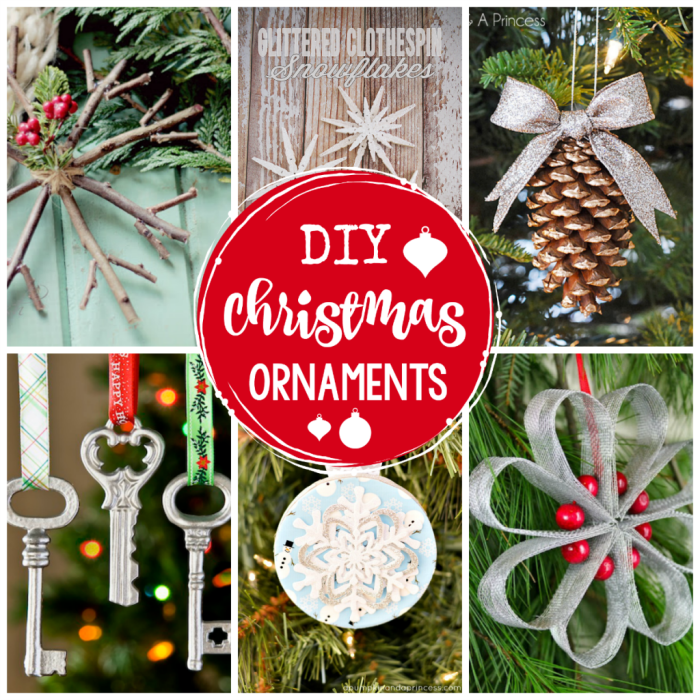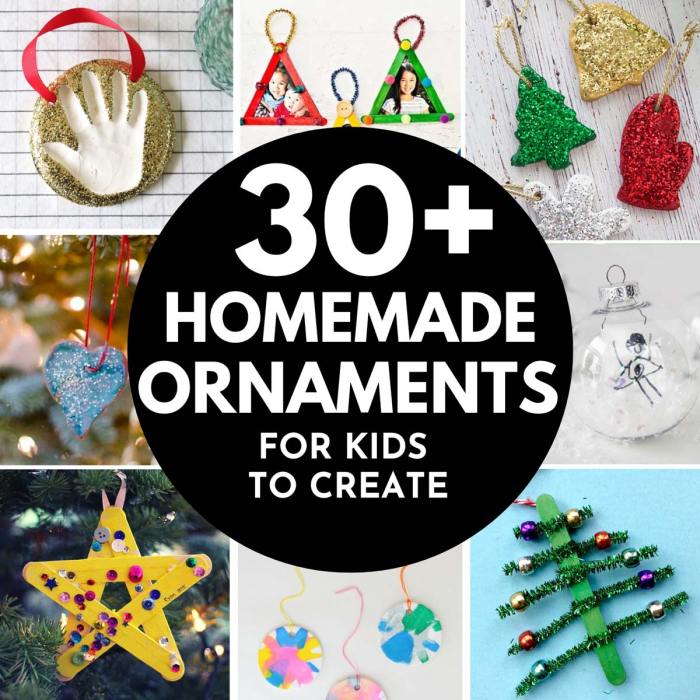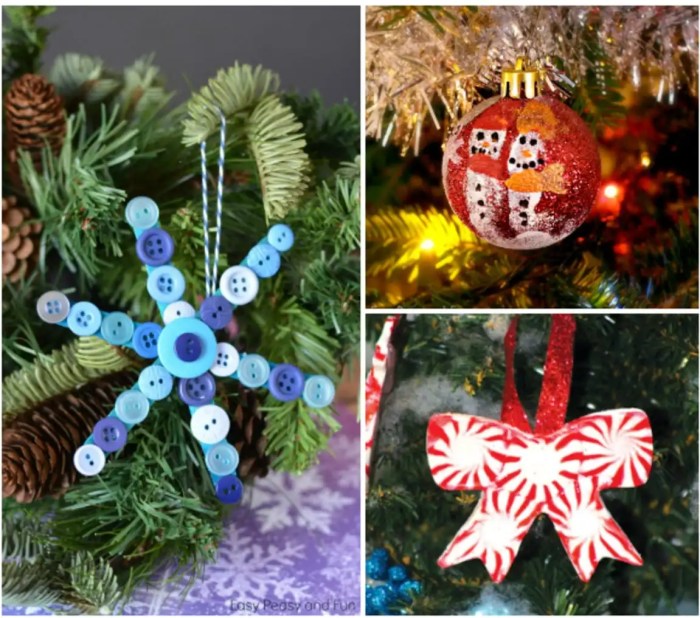Materials for DIY Christmas Ornaments

Christmas ornament ideas diy – Creating beautiful and unique Christmas ornaments is a rewarding experience, especially when crafting them yourself. The choice of materials significantly impacts the final look, durability, and overall feel of your ornaments. Careful consideration of material properties and sourcing is key to a successful project.
Selecting the right materials is paramount to creating durable and visually appealing DIY Christmas ornaments. The longevity of your handcrafted decorations depends heavily on the quality and suitability of the chosen materials. Understanding the source and cost-effectiveness of different materials is also crucial for budget-conscious crafters.
Material Selection for DIY Christmas Ornaments
| Material | Source | Cost Estimate | Uses in Ornament Making |
|---|---|---|---|
| Cardboard | Craft stores, recycling | $0 – $5 (depending on size and type) | Creating bases for layered ornaments, forming simple shapes, adding texture |
| Felt | Craft stores, online retailers | $5 – $15 (depending on quantity and type) | Cutting out shapes, creating soft and textured ornaments, layering for dimensional effects |
| Wooden Beads | Craft stores, online retailers | $5 – $20 (depending on quantity and size) | Stringing to create garlands, incorporating into larger ornaments, adding embellishments |
| Pine Cones | Outdoor collection (check for local regulations) | $0 (free, if collected) | Natural ornaments, bases for paint and glitter applications, adding rustic charm |
| Paper | Craft stores, recycling | $0 – $10 (depending on type and quantity) | Origami ornaments, paper mache bases, creating intricate cut-out designs |
Sustainable and Alternative Materials for Eco-Friendly Ornaments, Christmas ornament ideas diy
Choosing sustainable materials reduces the environmental impact of your crafting projects. Many readily available materials can be repurposed or sourced ethically for eco-conscious ornament making.
Instead of purchasing new materials, consider utilizing recycled materials like cardboard, fabric scraps, and newspaper. Natural elements such as twigs, leaves (preserved or dried), and seeds offer unique textures and aesthetic qualities. For instance, dried orange slices or cinnamon sticks create delightful aromatic ornaments. Using biodegradable glitter and paints further enhances the eco-friendly aspect of your creations.
Remember to source materials responsibly, minimizing environmental impact and supporting sustainable practices.
Importance of High-Quality Materials for Durability
The durability of your Christmas ornaments is directly related to the quality of the materials used. High-quality materials are more resistant to damage, ensuring your ornaments last for many years.
Investing in durable materials, such as sturdy cardboard or high-thread-count felt, prevents tearing or breaking. Similarly, using strong adhesives and high-quality paints enhances the longevity of your creations. Ornaments made from robust materials will withstand handling and storage better than those made from flimsy or low-quality materials. This translates to a longer lifespan for your handmade ornaments, reducing the need for frequent replacements and minimizing waste.
Easy DIY Ornament Projects for Beginners

Creating beautiful Christmas ornaments doesn’t require advanced crafting skills. These simple projects are perfect for beginners, offering a rewarding and enjoyable experience for all ages. They utilize readily available materials and straightforward techniques, making them ideal for family crafting sessions or individual creative pursuits. The sense of accomplishment derived from making your own ornaments adds a unique and personal touch to your holiday decorations.
Salt Dough Ornaments
Salt dough ornaments are a classic and versatile choice for beginners. The process involves mixing simple ingredients, shaping the dough, baking it until hardened, and then decorating to your heart’s content. This method allows for a wide range of creative expressions, from simple shapes to intricate designs.
- Mixing the Dough: Combine 4 cups of flour, 1 cup of salt, and 1 ½ cups of warm water in a large bowl. Mix thoroughly until a smooth, pliable dough forms. If the dough is too sticky, add more flour; if it’s too dry, add a little more water.
- Shaping the Ornaments: Roll out the dough to about ¼ inch thickness. Use cookie cutters to create various shapes, or roll and shape the dough by hand into stars, balls, or other desired forms. Use a straw to poke a hole at the top of each ornament before baking for hanging.
- Baking the Ornaments: Preheat your oven to 250°F (120°C). Place the ornaments on a baking sheet lined with parchment paper. Bake for 2-3 hours, or until the ornaments are completely hard and dry. Let them cool completely before decorating.
- Decorating the Ornaments: Once cool, unleash your creativity! Use acrylic paints, glitter, markers, sequins, or other embellishments to decorate your ornaments. You can create simple designs or elaborate scenes, depending on your preference. Seal the finished ornaments with a clear sealant to protect the decorations and add durability.
Troubleshooting Tip: If your salt dough ornaments crack during baking, it’s likely due to uneven baking or too high a temperature. Try reducing the oven temperature and baking for a longer time, ensuring even heat distribution in the oven.
Pinecone Ornaments
Pinecones, readily available in nature, offer a rustic and charming base for simple ornaments. Their natural texture and shape lend themselves well to minimal decoration, allowing the beauty of the pinecone to shine through. This project emphasizes natural elements, creating a simple yet elegant ornament.
- Gathering Pinecones: Collect pinecones from your yard, a park, or a forest. Ensure they are clean and dry before using them.
- Preparing the Pinecones: If necessary, gently brush off any dirt or debris from the pinecones. You may want to bake them in a low oven (around 200°F for about 30 minutes) to kill any insects and help them open up fully. Let them cool completely.
- Adding Embellishments: Use small amounts of hot glue to attach small embellishments such as miniature artificial berries, small jingle bells, or miniature ornaments to the pinecone. You could also wrap twine or ribbon around the base of the pinecone to create a hanger.
Troubleshooting Tip: If your hot glue is messy, apply it in small amounts and work quickly. Consider using a glue gun with a low temperature setting to prevent burning the pinecone.
Paper Snowflake Ornaments
Paper snowflakes are a classic and easily accessible craft. This project is perfect for children and adults alike, encouraging creativity and fine motor skills. The delicate nature of snowflakes adds a touch of elegance to your Christmas tree.
- Preparing the Paper: Use square sheets of paper. The size of the paper will determine the size of your snowflake. White or colored paper can be used, depending on your preference.
- Folding the Paper: Fold the paper in half, then in half again, and then in half one more time to create a small triangle.
- Cutting the Snowflake: Carefully cut various shapes into the edges of the folded paper. Be creative with your cuts! The more intricate the cuts, the more detailed the snowflake will be.
- Unfolding the Snowflake: Gently unfold the paper to reveal your snowflake. You can hang it with a small hole punched at the top or use a small piece of tape to adhere it to a larger piece of cardstock or ribbon for hanging.
Troubleshooting Tip: If your cuts are too large, the snowflake may not hold its shape well. Try making smaller, more precise cuts for a sturdier snowflake. Experiment with different folding techniques for varied results.
Displaying and Preserving DIY Christmas Ornaments
Creating beautiful, handcrafted Christmas ornaments is a rewarding experience. However, the joy extends beyond the making; properly displaying and preserving these cherished items ensures they bring festive cheer for years to come, becoming treasured heirlooms passed down through generations, much like the intricate weavings and carvings passed down in Batak traditions. Careful consideration of both display and storage methods will safeguard your unique creations.The longevity and visual appeal of your DIY ornaments depend heavily on how you choose to showcase and store them.
A thoughtful approach ensures your handmade treasures remain a source of holiday joy for many Christmases to come.
Creative Display Ideas for Homemade Ornaments
Displaying your DIY ornaments creatively enhances their charm and adds a personal touch to your holiday décor. Consider the style and material of your ornaments when selecting a display method. For instance, delicate paper ornaments might be best suited for a less crowded area, while sturdier wooden ornaments can handle a more densely decorated tree.A simple yet elegant approach involves using your ornaments to complement an existing theme.
Crafting unique Christmas ornament ideas DIY is a rewarding holiday activity, expanding beyond simple store-bought decorations. To truly personalize your festive space, consider broader christmas decoration ideas DIY projects, which can then inspire even more creative ornament designs. From repurposed materials to intricate handcrafted pieces, your DIY ornaments become cherished keepsakes reflecting your personal style.
If your home features a rustic aesthetic, consider displaying ornaments made from natural materials like pinecones or twigs. For a more modern look, opt for geometric designs or minimalist ornaments. Consider grouping similar ornaments together on the tree or mantelpiece to create a visually appealing effect, mirroring the careful arrangement of traditional Batak textiles in a home.
Preserving DIY Ornaments for Long-Term Storage
Proper storage is crucial for maintaining the quality of your handmade ornaments. Before storing, ensure your ornaments are completely dry to prevent mold or mildew. Delicate ornaments should be individually wrapped in acid-free tissue paper to prevent scratching or breakage. More robust ornaments can be stored in labelled boxes, separated by layers of bubble wrap or soft cloth to cushion them.
Storing them in a cool, dry place, away from direct sunlight and extreme temperatures, will also help preserve their vibrancy and prevent damage. This careful preservation mirrors the meticulous care Batak artisans take in storing their precious handcrafted items.
Protecting Delicate Ornaments from Damage
Delicate ornaments, such as those made from paper, glass, or fragile materials, require extra care. When hanging these ornaments on the tree, use sturdy hooks or ribbon to avoid accidental breakage. Avoid overcrowding the tree, leaving enough space between ornaments to minimize the risk of collisions. For particularly fragile pieces, consider displaying them on a separate shelf or in a glass-fronted cabinet, away from the bustling activity of a decorated tree.
This approach ensures their safety and allows you to fully appreciate their intricate details. Think of it as safeguarding a prized Batak heirloom – the same level of care and protection should be afforded to your cherished handmade ornaments.
Beyond the Basics: Christmas Ornament Ideas Diy

Moving beyond simple paint and glitter, let’s explore some truly unique approaches to crafting Christmas ornaments. These techniques offer opportunities to showcase individual creativity and produce ornaments with exceptional visual appeal, transforming ordinary materials into extraordinary decorations. The following methods offer varying levels of complexity, requiring different materials and yielding distinct aesthetic results.
Polymer Clay Ornaments
Polymer clay provides a versatile medium for creating intricately detailed ornaments. Its moldability allows for the creation of complex shapes and the incorporation of fine details, from miniature figurines to textured surfaces. The curing process ensures durability, making these ornaments suitable for repeated use year after year. The difficulty level is moderate, requiring some practice to master techniques like blending colors and achieving smooth surfaces.
Materials needed include polymer clay in various colors, a rolling pin, sculpting tools, a baking oven, and varnish for a protective finish. A visually striking example could be a miniature replica of a traditional Batak house, complete with intricate roof details and tiny figures representing people celebrating Christmas. The vibrant colors of the clay, reflecting the rich hues found in traditional Batak textiles, would make it a unique and culturally significant ornament.
Paper Quilling Ornaments
This technique utilizes the art of rolling and shaping strips of paper to create intricate designs. The delicate nature of paper quilling allows for the creation of ornaments with a distinctly elegant and refined aesthetic. While the process requires patience and precision, it’s relatively easy to learn, making it suitable for beginners. Materials are readily available and inexpensive, primarily consisting of colored paper strips, glue, and a quilling tool (though a toothpick can suffice).
An example of a visually appealing ornament could be a snowflake crafted from tightly rolled and meticulously arranged paper coils, creating a three-dimensional effect with varying shades of blue and white, evoking the feeling of a winter’s day. The delicate precision of the coils would showcase the beauty of the technique, resulting in a sophisticated and eye-catching ornament.
Natural Material Ornaments
Utilizing natural materials such as pine cones, twigs, dried flowers, and berries allows for the creation of ornaments that reflect the beauty of nature. This method offers a rustic and organic aesthetic, perfect for those seeking a more eco-friendly and traditional approach. The difficulty level is low to moderate, depending on the complexity of the design and the chosen materials.
Materials are readily available, particularly in the winter season, and may include items gathered during nature walks. A striking example would be a pine cone ornament adorned with miniature dried flowers and berries, carefully glued and arranged to create a visually pleasing composition. The natural textures and colors of the materials would create a rustic charm, with the contrasting colors and textures providing a sense of depth and interest.
This ornament could be further enhanced with a touch of natural twine or ribbon, adding to its rustic appeal.
FAQ Compilation
What is the best time to start making DIY Christmas ornaments?
Ideally, begin a few weeks before Christmas to allow ample time for crafting and drying, especially for projects involving paint or glue.
How can I make my DIY ornaments last longer?
Use high-quality materials, seal painted ornaments with a sealant, and store them carefully in a cool, dry place away from direct sunlight.
Can I involve children in making DIY Christmas ornaments?
Absolutely! Choose age-appropriate projects and supervise children closely, especially when using sharp objects or hot materials.
Where can I find inspiration for unique DIY ornament designs?
Browse Pinterest, Etsy, and craft blogs for a wealth of ideas. Consider incorporating family photos, pressed flowers, or other personal mementos.
